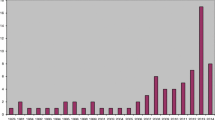Abstract
We address the Clarke and Wright (CW) savings algorithm proposed for the Capacitated Vehicle Routing Problem. We first consider a recent enhancement that uses the put first larger items idea originally proposed for the bin packing problem and show that the conflicting idea of putting smaller items first has a comparable performance. Next, we propose a robust enhancement to the CW savings formulation. The proposed formulation is normalized to efficiently solve different problems, independent from the measurement units and parameter intervals. To test the performance of the proposed savings function, we conduct an extensive computational study on a large set of well-known instances from the literature. Our results show that the proposed savings function provides shorter distances in the majority of the instances and the average performance is significantly better than previously presented enhancements.

Similar content being viewed by others
References
Altınel İK and Öncan T (2005). A new enhancement of the Clarke and Wright savings heuristic for the capacitated vehicle routing problem . J Opl Res Soc 56: 954–961.
Augerat P, Belenguer JM, Benavent E, Corberán A, Naddef D and Rinaldi G (1995). Computational results with a branch and cut code for the capacitated vehicle routing problem. Technical Report RR 949-M, Université Joseph Fourier, Grenoble.
Christofides N and Eilon S (1969). An algorithm for the vehicle dispatching problem . Opl Res Quart 20: 309–318.
Christofides N, Mingozzi A and Toth P (1979). The vehicle routing problem . In: Christofides N, Mingozzi A, Toth P and Sandi C (eds). Combinatorial Optimization. Wiley: Chichester, pp. 315–338.
Clarke G and Wright JW (1964). Scheduling of vehicles from a central depot to a number of delivery points . Opns Res 12: 568–581.
Dantzig GB and Ramser JH (1959). The truck dispatching problem . Mngt Sci 6: 80–91.
Doyuran T and Çatay B (2008). Two enhanced savings functions for the Clark–Wright algorithm . In: Blecker T, Kersten W and Gertz C (eds). Management in Logistics Networks and Nodes: Concepts, Technology and Applications. Series on Operations and Technology Management 8. Erich Schmidt Verlag: Berlin, pp. 245–258.
Gaskell TJ (1967). Bases for vehicle fleet scheduling . Opns Res 18: 281–295.
Laporte G and Semet F (2001). Classical heuristics for the vehicle routing problem . In: Toth P and Vigo D (eds). The Vehicle Routing Problem. SIAM Monographs on Discrete Mathematics and Applications. SIAM Publishing: Philadelphia, PA, pp. 109–128.
Laporte G, Gendreau M, Potvin J and Semet F (2000). Classical and modern heuristics for the vehicle routing problem . Int Trans Opns Res 7: 285–300.
Martello S and Toth P (1990). Knapsack Problems: Algorithms and Computer Implementations . John Wiley & Sons: New York, NY.
Paessens H (1988). The savings algorithm for the vehicle routing problem . Eur J Opl Res 34: 336–344.
Toth P and Vigo D (2002). In: The Vehicle Routing Problem. SIAM Monographs on Discrete Mathematics and Applications. SIAM Publishing: Philadelphia, PA.
Wren A and Holiday A (1972). Computer scheduling of vehicles from one or more depots to a number of delivery points . Opl Res Quart 23: 333–344.
Yellow P (1970). A computational modification to the savings method of vehicle scheduling . Opl Res Quart 21: 281–283.
Author information
Authors and Affiliations
Corresponding author
Appendix
Appendix
Tables A1, A2, A3, A4 and A5 consist of only capacity-restricted instances whereas the instances in Table A6 include a unique data set CD of Christofides et al's with maximum route length constraint (referred to as Chr CD). This data set was not reported in Altınel and Öncan (2005), but we prefer to test it to observe the performance of our algorithm when a maximum route length is imposed. In all the tables, the instances are represented in the first column and best-known results and the results given by classical CW method are included in the second and third column, respectively. The results obtained using Paessens’ and Altınel and Öncan's savings function are denoted as P and AÖ, respectively, and reported with the corresponding parameter values (λ,μ,) and (λ,μ,v), respectively. ROBUST column shows the results obtained using the proposed savings function (7) along with the corresponding parameter values as well. Our experiments revealed that the parameter v changing within the interval [−0.1,0.1] with an increment of 0.01 works well. The ‘%Imp’ column gives the improvements in the distances obtained by P, AÖ, and ROBUST, respectively, in comparison with CW and is calculated as (CW–P)/CW, (CW–AÖ)/CW, and (CW–ROBUST)/CW, respectively.
Rights and permissions
About this article
Cite this article
Doyuran, T., Çatay, B. A robust enhancement to the Clarke–Wright savings algorithm. J Oper Res Soc 62, 223–231 (2011). https://doi.org/10.1057/jors.2009.176
Received:
Accepted:
Published:
Issue Date:
DOI: https://doi.org/10.1057/jors.2009.176




